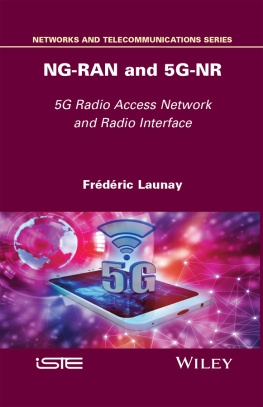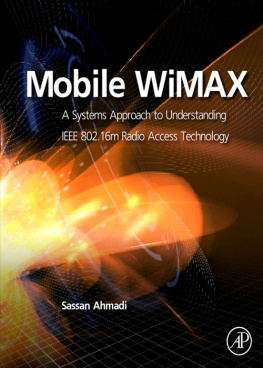
NG-RAN and 5G-NR
5G Radio Access Network and Radio Interface
Frdric Launay

First published 2021 in Great Britain and the United States by ISTE Ltd and John Wiley & Sons, Inc.
Apart from any fair dealing for the purposes of research or private study, or criticism or review, as permitted under the Copyright, Designs and Patents Act 1988, this publication may only be reproduced, stored or transmitted, in any form or by any means, with the prior permission in writing of the publishers, or in the case of reprographic reproduction in accordance with the terms and licenses issued by the CLA. Enquiries concerning reproduction outside these terms should be sent to the publishers at the undermentioned address:
ISTE Ltd
27-37 St Georges Road
London SW19 4EU
UK
www.iste.co.uk
John Wiley & Sons, Inc.
111 River Street
Hoboken, NJ 07030
USA
www.wiley.com
ISTE Ltd 2021
The rights of Frdric Launay to be identified as the author of this work have been asserted by him in accordance with the Copyright, Designs and Patents Act 1988.
Library of Congress Control Number: 2021935849
British Library Cataloguing-in-Publication Data
A CIP record for this book is available from the British Library
ISBN 978-1-78630-628-9
Preface
This book aims to describe the deployment of 5G-NSA and 5G-SA.
For the 5G-NSA mode, dual MR-DC connectivity is based on radio measurements allowing the master 4G base station MeNB to add or to remove a 5G secondary node SgNB.
For the 5G-SA mode, the mobile is attached to the 5G core network. Even though this book is devoted to the radio access network, the mobile registration, establishment procedures and re-establishment procedures are also explained.
This book describes the architecture of the NG radio access network and the 5G-NR radio interface according to 3GPP (3rd Generation Partnership Project) specifications.
The 5G-NR radio interface was introduced in Release 15 of the 3GPP standards.
The 5G-NR radio interface is the interface between the UE mobile (User Equipment) and the 5GC mobile network (5G Core).
presents the 5G-NSA and the 5G-SA deployment architecture. It describes the radio access entities and functions of the 5G-SA core network and presents the functions supported by the radio access and the 5GC core network.
In order to prepare RAN virtualization, the radio protocols of the gNB entity are supported by two units: a centralized unit and a distributed unit. This separation creates new interfaces called F1 on the radio access.
presents the interfaces between the entities of NG-RAN radio access. It describes the protocol architecture on the Xn interface, the NG interface and the F1 interface, as well as the procedures for managing the interfaces of the NG-RAN network.
Similar to 4G CUPS (Control User Plane Separation) evolution, the 5GC network architecture separates the control plane to the user plane. The 5G-NSA and the 5G-SA architectures will be described by detailing interfaces and applications between the radio access entities and between the radio access and the network core (NG interfaces).
presents general procedures for 5G-NSA and 5G-SA modes. It describes the procedures on the radio access network concerning the cell search, the bearer establishment, the mobility management, the management of the secondary node, the beam management, as well as the procedures to the core network such as attachment and session establishment.
5G-NR spectrum allocation is more flexible compared to 4G LTE. In the time domain, frame flexibility is improved with the introduction of new numerologies. In the frequency domain, flexibility is achieved with bandwidth partitioning allocated to the terminals.
In order to avoid future development constraints, the management of the radio band is refined. describes the reference signals, physical signals, physical channels and their allocation on the 5G bandwidth.
5G improves the users throughput with active antenna technologies. Spatial multiplexing improvements are presented in both FR1 and FR2 bands. This chapter describes single- and multi-panel antennas, which require new measurements of the CSI radio channel.
To achieve 20 Gbps in the downlink direction and 10 Gbps in the uplink direction, the 5G-NR radio interface needs the following characteristics:
the maximum radio channel bandwidth is 100 MHz for the FR1 band and 400 MHz for the FR2 band;
carrier aggregation allows us to extend the channel bandwidth to 1 GHz;
256-QAM (Quadrature Amplitude Modulation);
MIMO (Multiple Input Multiple Output) 8x8 transmission mode is used in downlink.
also details the mapping of physical channels and physical signals on resource elements.
presents the physical layer mechanisms to improve throughput and coverage. It describes the SUL mode, the carrier aggregation mechanism, dual connectivity and spectrum sharing for 4G/5G coexistence.
presents MIMO mechanisms used to improve the robustness of the transmission (diversity), the bit rate (SU-MIMO, MU-MIMO) and the reduction of interference (beamforming). It describes the evolution of antenna capabilities from MIMO to massive-MIMO and single-panel or multi-panel transmission mechanisms. The procedure for managing the beams and improving data rate is described with the use of the code book for the uplink and downlink transmissions.
presents the partitioning of the 5G band. It describes initial band partitioning and BWP band switching, allowing the mobile to camp on a cell and, under the control of the base station, to adapt its radio capabilities to the traffic load. It also describes the search area and CORESET control resource elements.
introduces the data link layer. It describes the different SDAP, PDCP, RLC and MAC sublayers by presenting their functional role and the services between the different sublayers. For each of the sublayers, the structure of the protocol is detailed.
presents the messages sent by the RRC layer: broadcasting information, connection management, measurement configuration. It details the MIB and SIB messages, the procedures for establishing the radio link and the mobility of the mobile, as well as the elements to be measured.
A summary of the content of these nine chapters is provided in the following table.
| Chapter | Designation | Content |
|---|
| 1 | NG-RAN network architecture | Functional architecture NSA/SA
Identities
UE context
gNB-CU/DU
QoS and network slicing |
| 2 | NG-RAN protocol architecture | Protocol architecture
eCPRI functional splitting
Interface protocols (Xn, NG, F1)
NG-AP and Xn procedure |
| 3 | Radio access procedure | Search cell
Access procedure
Data transmission procedure
Session management
Secondary node establishment
Beam management
Attachment |
| 4 | Physical layer of the 5G-NR interface | Frequency band
Multiplexing structure
Reference signals: PSS, SSS, CSI-RS, PT-RS, RIM-RS
Physical signals: PSS, SSS
Physical channels: PBCH, PDCCH, PDSCH, PMCH, PUSCH, PUCCH, PRACH |
| 5 | Operations on frequency bands | Carrier aggregation
SUL mode
Dual connectivity |
| 6 | Multi-antenna structure | SU-MIMO
MU-MIMO
Beamforming
Massive-MIMO
|
Next page










